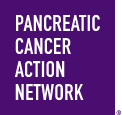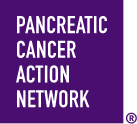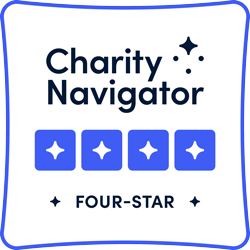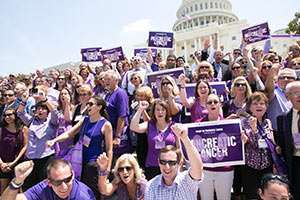
Some 450 advocates told Congress to “Stomp on Pancreatic Cancer” at Advocacy Day 2014.
Just hours before a December 11 deadline, Congress passed a spending bill to fund the government for the remaining nine months of the government’s 2015 fiscal year. The National Institutes of Health (NIH) will receive $30.08 billion in 2015 – a $150 million (0.5 percent) increase from last year – which includes $4.95 billion for the National Cancer Institute (NCI) – a $27.2 million (0.6 percent) increase from last year.
Getting Congress to pass a spending bill rather than another continuing resolution (CR), or stop-gap funding measure, was our chief legislative goal in 2014. While the increases for the NIH and the NCI were minimal, the alternative – a full year CR – would have meant more cuts to these institutes, further hampering their ability to conduct critical cancer research. We also asked Congress to ensure that the NCI’s funding increase was kept in line with the NIH’s, since that has not been the case for the last several years. We are pleased to report that Congress heeded our call. In fact, most institutes under the NIH received about a 0.3 percent increase, while the NCI’s increase was 0.6 percent. The funding decisions Congress made were no doubt influenced by what they heard from constituents like you and constituents of our allies in the cancer research community.
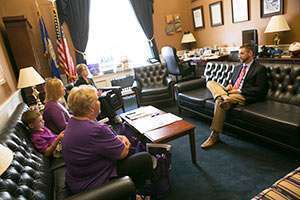
Advocates engage in an in-person meeting on Capitol Hill at Advocacy Day 2014.
Our second legislative goal in 2014 was to ensure that Congress continued to include pancreatic cancer in the Department of Defense’s Peer-Reviewed Cancer Research Program (PRCRP) and that they increased funding for this key program. The PRCRP funds research into several different cancers, but even a fraction of funding from this program presents an opportunity for our researchers. In 2014, advocates sent over 2,300 emails about this issue to their members of Congress. Congress, in turn, not only included pancreatic cancer in the PRCRP, but they doubled the total amount of funding that the program will receive in 2015 from $25 million to $50 million!
Our final ask of Congress in 2014 was that its members join the Congressional Caucus on the Deadliest Cancers. Launched in May 2014, the caucus seeks to raise awareness about the deadliest forms of cancer, such as pancreatic cancer, and advocates for research funding and other measures to increase survival rates for these cancers. In just six months, advocates recruited 37 legislators to the caucus, forming a key base of champions who can lead our advocacy efforts in Congress moving forward.
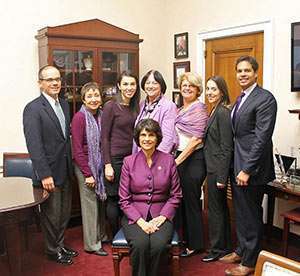
On November 13, 2014, Rep. Lucille Roybal-Allard of California and her staff wore Purple for a Purpose to mark World Pancreatic Cancer Day.
Impassioned grassroots supporters were critical in making all of this happen. In 2014, advocates sent more than 21,000 emails and made 2,300 phone calls to their members of Congress. On Advocacy Day 2014, approximately 450 advocates from all 50 states gathered on Capitol Hill and participated in 322 meetings with legislators and their staff. Two months later, when Congress was home for the August recess, advocates scheduled nearly 60 district meetings with their members of Congress all over the country.
But advocates were not done making their mark in 2014. On November 13, the Pancreatic Cancer Action Network participated in the first-ever World Pancreatic Cancer Day and asked all of our supporters to wear Purple for a Purpose. Advocates took this call-to-action one step further and asked Congress to participate in the campaign, too. And once again, Congress listened. On November 13, almost 40 bipartisan lawmakers wore purple and posted pictures of themselves with supportive messages on Facebook and Twitter. Two legislators even gave speeches about pancreatic cancer on the floor of the U.S. House. It was a great display of support!
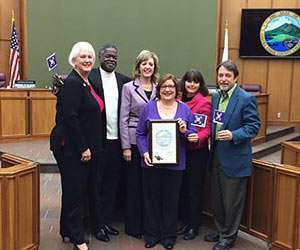
Advocacy volunteer Judy Lloyd of the Silicon Valley Affiliate in Northern California accepts a proclamation declaring November “Pancreatic Cancer Awareness Month” from the Contra Costa County Board of Supervisors.
Finally, many new people signed on to participate in our advocacy program in 2014. During the Three-Week Challenge, about 200 new supporters signed up to become advocates. And this past fall, more than 120 new advocacy volunteers participated in our annual proclamations campaign, helping to secure a total of 658 proclamations declaring November “Pancreatic Cancer Awareness Month.” Advocates used social media, too, to recruit new supporters to our cause by posting thousands of messages on Facebook and Twitter and changing their profile pictures throughout the year to reflect our various advocacy campaigns.
With our key volunteer Advocacy Chairs and Community Advocates leading the way, we made an impact on Capitol Hill and in every state in the country. Congress heard our call for additional resources for medical research – and acted. Members of Congress are staunchly committed to our cause because advocates have built close working relationships with their legislators.
Clearly, advocates have not lost momentum since the passage of the Recalcitrant Cancer Research Act in 2012. The successful push for increased federal research funding is key to the effective implementation of the Act. Click here to see the progress that the NCI has made in acting on the four research initiatives that were recommended in the bill’s scientific framework.
We are incredibly grateful for our dedicated and passionate network of advocates across the country. The push for more funding is far from over, and your continued involvement is critical to making an even bigger impact on policymakers in 2015. Sign up here to become an advocate today!
